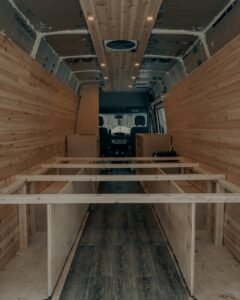Have you meticulously chosen your flooring for style and durability, only to discover later it warps underfoot from improper moisture management? Perhaps you opted for a beautiful exposed ceiling, unaware condensation would turn it into a mould haven. These are just a few pitfalls awaiting the unwary van builder.
Wouldn’t you rather avoid these headaches and costly repairs? This guide equips you with the knowledge to make informed decisions, ensuring your van’s floor and ceiling become the envy of the campground (and stay dry and squeak-free).
Fasten your seatbelt and delve into these essential tips. By learning from the mistakes of others, you’ll be well on your way to crafting a van conversion that’s as functional as it is fabulous.
Installing van flooring and ceiling is easier than you think. However, it’s the choice of MATERIALS that’ll determine whether you’re successful and living in comfort. For the floor, you’ll want to use a combination of marine-grade (treated) plywood and polyiso. You’ll then lift that off the bottom of the van with strips of plywood (approx. 1-inch thick) to decouple the subfloor. For the ceiling, you can use a combination of polyiso, aluminum foil tape and strips of 1×4 or 1×6 lumber (treated is best). Now, let’s learn how to install your van floor/ceiling using these 5 tips…
Tip 1: Use polyiso insulation as a vapour barrier
Using polyiso insulation is a fantastic choice for your van’s floor and ceiling, but placement is key to avoid moisture problems. Here’s how to use polyiso effectively:
- Resist the urge to glue polyiso directly against the van floor and ceiling. This creates a moisture trap, even with a seemingly perfect vapour barrier.
- Before installing polyiso, create an air gap for proper ventilation. Install a thin layer of treated wood battens (around 1 inch thick) on the floor.
- Once the air gap is created, install your polyiso insulation. Seal all seams between the polyiso sheets with aluminum foil tape for a complete vapour barrier. This powerful duo prevents moisture from reaching your van’s interior.
- Finally, finish your floor and ceiling with your chosen wood material (like marine-grade plywood). This layering system creates a breathable barrier against moisture, promoting a healthy and comfortable van environment.
Tip 2: Use treated wood and mould-resistant primer
Moisture may be a sneaky foe, but with treated wood and a little paint power, you can create a winning defence for your van’s floor and ceiling!
- When choosing wood for your van’s subfloor (plywood) and structural elements (dimensional lumber, like battens), opt for treated varieties. This wood undergoes a special process to resist moisture absorption, warping, and even insect infestation.
- While treated wood offers excellent moisture resistance, adding a layer of mould-resistant paint can provide an extra layer of defence, especially for areas prone to higher humidity (like the bathroom or kitchen).
Here’s why this tip is a winner:
- Double Defense: Treated wood combined with mould-resistant paint creates a powerful one-two punch against moisture, ensuring your van’s floor and ceiling stay healthy and stable.
- Peace of Mind: Knowing you’ve taken extra precautions against moisture problems allows you to relax and enjoy your van adventures.
- Versatility: Treated wood can be painted in a variety of colors to match your van’s overall design aesthetic.
Remember: While paint offers additional protection, treated wood itself is highly moisture-resistant. Choose the approach that best suits your comfort level and budget.
Tip 3: Don’t use screws or bolts to fasten the subfloor
While traditional methods involve screwing or bolting down the subfloor, there’s a clever alternative – the free-floating floor. Here’s how it works:
- Instead of drilling numerous holes in your van’s floor (which can be risky due to unseen obstacles), embrace a weight-based approach. Utilize the weight of the materials, furniture and impeccable cutting to ensure a tight-fitting floor.
- For added peace of mind, consider using a high-quality construction adhesive along the edges and seams of the subfloor panels. This adds an extra layer of security without the need for extensive drilling.
- A thin bead of silicone sealant along the subfloor perimeter can further enhance water resistance and prevent moisture from seeping underneath.
Benefits of the Free-Floating Floor:
- Reduced Risk: Eliminates the risk of accidentally drilling into unseen van components.
- Preserves the Metal: Minimizes the number of holes in the van’s floor, helping to prevent rust and corrosion.
- Easy Removal: If ever needed, a free-floating floor can be easily lifted and replaced without the hassle of removing screws or bolts.
Tip 4: Use vinyl plank flooring to make your van floor water-resistant
Your van’s floor needs to be tough enough to handle the elements and stylish enough to reflect your adventurous spirit. Here’s why vinyl flooring emerges as the champion:
- Vinyl boasts a water-resistant backing, usually made of rubber. This creates a barrier against spills, mud, and even tracked-in moisture, protecting your van’s subfloor from water damage.
- Many vinyl planks come with built-in sound dampening properties. This translates to a quieter ride, minimizing road noise and creating a more peaceful living environment.
- Vinyl offers a wide variety of colors, patterns, and textures to match any van design aesthetic. Whether you crave a classic wood look or a modern, bold statement, vinyl has you covered.
Vinyl vs. the Rest:
- MDF Mishap: While MDF planks may seem appealing, their susceptibility to water damage makes them a risky choice for van floors. Spills and moisture can cause warping and deterioration.
- Carpet Catastrophe: Carpets, though seemingly cozy, are notorious for trapping moisture. This can lead to mold growth and unpleasant odors, especially in a van environment.
Vinyl’s Winning Formula:
By combining water resistance, sound dampening, and design versatility, vinyl flooring delivers the perfect trifecta for your van’s floor. It protects your investment, enhances comfort, and injects a touch of personal style into your mobile adventure haven.
Tip 5: Coat your screws in silicone to prevent rust and corrosion
While a free-floating floor (Tip #3) is a great option, some van builds may require fastening the ceiling components using screws or bolts. Here’s how to add an extra layer of protection against rust and corrosion:
- Before screwing your 1x4s or 1x6s into the ceiling, apply a small bead of silicone sealant around the screw threads and the inner hole of the screw hole.
- This thin layer of silicone acts as a double-edged sword:
- Sealing the Deal: It fills any gaps between the screw and the metal, preventing moisture from seeping in and causing rust.
- Screw Thread Security: The silicone coats the screw threads, adding an extra layer of protection against corrosion.
Silicone Sealant Savvy – A Simple Step, Big Benefits:
Taking a few moments to apply silicone sealant around your ceiling screws is a simple yet highly effective way to prevent future headaches. It adds minimal time to the installation process but offers significant long-term benefits, ensuring your van’s ceiling maintains its structural integrity and visual appeal for years to come.
Summary
Congratulations! You’re embarking on the incredible journey of building your dream van. But before diving into aesthetics, let’s ensure the foundation of your comfort – the floor and ceiling. Here’s what we learned today…
- Creating Vapour Barriers: We’ll show you how to create a breathable vapour barrier that keeps condensation at bay, ensuring a healthy and comfortable van environment.
- Treated Wood and Primer: Discover the power of treated wood and clever application techniques to fortify your floor and ceiling against moisture’s sneaky attacks.
- Free-Floating Flooring: Explore a clever approach to securing your subfloor that eliminates drilling and potential risks, all while utilizing the power of weight distribution.
- Vinyl Flooring: Vinyl flooring emerges as a champion, offering superior water resistance, sound-dampening properties, and a variety of styles to match your van’s personality.
- Silicone Coating on Screws: Learn a simple yet effective technique to shield your ceiling screws from the perils of rust and corrosion.
Ready to tackle the next stage of your van conversion?





